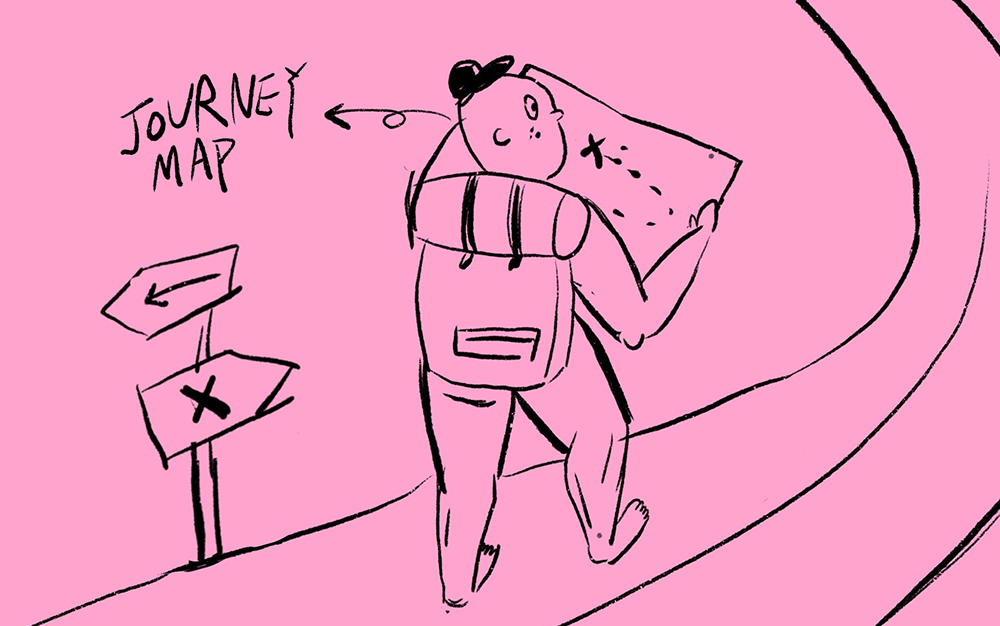A
cheat sheet to understanding your customers
WTF IS A CUSTOMER journey map?

©Somewhere Else
…and do you really need one?
If you’ve ever asked a customer where they first heard about your brand,
you’ve already filled in a piece of the puzzle.
If you’ve ever had a friend go undercover as a mystery shopper and report back to you, you’re definitely on the right track.
If you’ve ever tested your own product or service, congratulations! You’ve already started making a customer journey map.
If you’ve ever asked a customer where they first heard about your brand,
you’ve already filled in a piece of the puzzle.
If you’ve ever had a friend go undercover as a mystery shopper and report back to you, you’re definitely on the right track.
If you’ve ever tested your own product or service, congratulations! You’ve already started making a customer journey map.
CJMs are often confused with Customer Reviews. After all, they’re both tools that tell you what you can improve about your business, from the customer’s point of view. But that’s where the similarities end.
A Customer Journey Map (CJM) shows the changes in motivations, expectations, and actions of your customers as they experience your product or service.
While a Customer Review could come from anyone, a Customer Journey Map uses a typical target customer, or a Customer Persona
A Customer Review reflects an isolated experience. A Customer Journey Map shows how each experience links to the previous and the next.
Where a Customer Review is opinion-based, a customer journey map is observation-based. This ultimate difference makes a Customer Journey Map the better tool for decision-making, because it isn’t made up of subjective suggestions.
How To Make And Use
a Customer Journey Map
What are you mapping?
Your chosen journey can be very focussed and tangible. (Like a movement map of a customer entering your store for the first time, exploring your aisles, purchasing and leaving.)
It can also be an online journey. (A series of webpages visited, from landing page to checkout.)
Or, it could be very broad and span different channels. (Like a timeline starting from the minute a stranger hears about you, to their lifetime experience as a loyal customer.)
Your chosen journey can be very focussed and tangible. (Like a movement map of a customer entering your store for the first time, exploring your aisles, purchasing and leaving.)
It can also be an online journey. (A series of webpages visited, from landing page to checkout.)
Or, it could be very broad and span different channels. (Like a timeline starting from the minute a stranger hears about you, to their lifetime experience as a loyal customer.)
2)
Take the journey
Remember that every journey starts with a task. What is your customer trying to accomplish? Along the way, where are they getting frustrated? Where are they getting confused? Your job is not to explain, but to observe.
3) Mark out Touchpoints along the Journey
Touchpoints are any instance in which your customer comes into contact with your business. Each touchpoint is an opportunity to strengthen your brand.
These include:
- word-of-mouth and online ads
- physical interactions with your staff
- unwrapping the packaging of your product
- emailers and social media posts
Some key touchpoints are more impactful than others, but they all contribute to the experience of your brand.
For example:
Snapple turned a mundane, overlooked experience (unscrewing the cap on a bottled beverage) into a key touchpoint, when they started printing trivia on the underside of each bottle cap. Customers began to look forward to this moment of discovery and delight, and the experience became inextricably associated with Snapple’s brand.
These include:
- word-of-mouth and online ads
- physical interactions with your staff
- unwrapping the packaging of your product
- emailers and social media posts
Some key touchpoints are more impactful than others, but they all contribute to the experience of your brand.
For example:
Snapple turned a mundane, overlooked experience (unscrewing the cap on a bottled beverage) into a key touchpoint, when they started printing trivia on the underside of each bottle cap. Customers began to look forward to this moment of discovery and delight, and the experience became inextricably associated with Snapple’s brand.
4)Dissect each Touchpoint from the customer’s POV
Use your touchpoints to identify opportunities for improvement. Do this by answering the following questions.
At this particular Touchpoint, what is my customer:
- Motivated by?
- Expecting from me?
- Physically doing?
- Feeling?
You now have a map that shows you WHERE you can improve. It also shows you HOW to improve, according to what your customers are feeling and expecting at that Touchpoint. And it shows you how each customer experience links to the next, building up into a relationship with your brand.
The Customer Journey Map gives your business a god’s-eye-view of what your customer goes through. It’s based on observation and analysis. It powers decisions that lead directly to a better relationship with your customer. You need one.
At this particular Touchpoint, what is my customer:
- Motivated by?
- Expecting from me?
- Physically doing?
- Feeling?
You now have a map that shows you WHERE you can improve. It also shows you HOW to improve, according to what your customers are feeling and expecting at that Touchpoint. And it shows you how each customer experience links to the next, building up into a relationship with your brand.
The Customer Journey Map gives your business a god’s-eye-view of what your customer goes through. It’s based on observation and analysis. It powers decisions that lead directly to a better relationship with your customer. You need one.
Are there trained professionals for this?
We believe that every business owner can generate a usable Customer Journey Map on their own. But what if you want to involve teams from different parts of your business? What if your map spans multiple customer channels? How would you reconcile a map for more than one customer segment?
DesignSingapore Council now supports SMEs who want to improve their customer experience, with up to 70% subsidy on Customer Journey Mapping. Click here to find out more!

This kit contains DIY branding solutions, customisable to your pace and budget. Alternatively, request backup.
contact us︎





